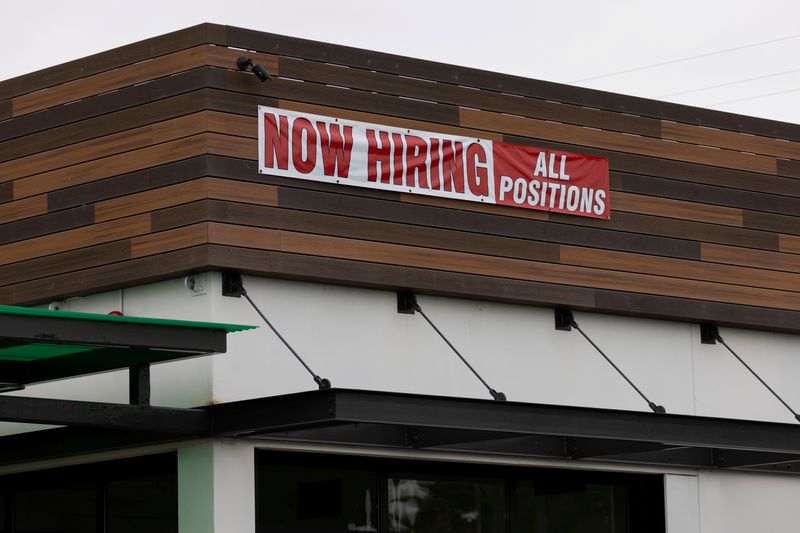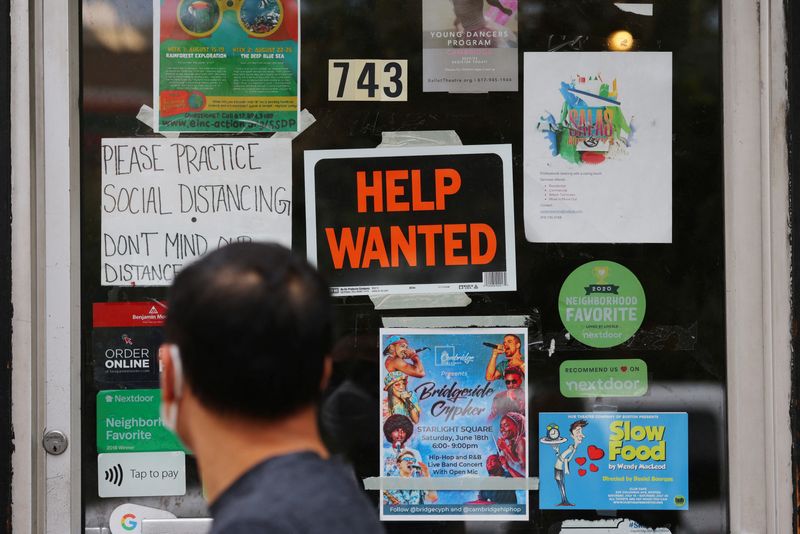By Lucia Mutikani
WASHINGTON (Reuters) - U.S. job growth accelerated in May, but a surge in the unemployment rate to a seven-month high of 3.7% suggested that labor market conditions were easing, which could give the Federal Reserve cover to skip an interest rate hike this month.
The increase in the unemployment rate from a 53-year low of 3.4% in April, which was reported by the Labor Department on Friday, was the largest since April 2020. Outside the COVID-19 pandemic, it was the biggest jump since 2010, reflecting a drop in household employment and a rise in the workforce. The gradual increase in the labor pool is easing pressure on businesses to raise wages.
Wage growth moderated last month, which should offer some comfort to Fed officials battling to bring inflation back to the U.S. central bank's 2% target. The mixed employment report offered more evidence that the economy was far from a recession, despite weakness in the interest-rate sensitive manufacturing sector and the housing market.
"American businesses are still aggressively hiring, likely to meet resilient consumer demand," said Sal Guatieri, a senior economist at BMO Capital Markets in Toronto.
"However, the other areas of softness in this report suggests that the labor market is losing steam. There's likely enough pockets of softness in this report for the Fed to pass on raising rates at the next meeting."
The survey of establishments showed nonfarm payrolls rose by 339,000 jobs last month. Economists polled by Reuters had forecast payrolls would increase by 190,000. The economy created 93,000 more jobs in March and April than previously estimated.
The economy needs to add 70,000-100,000 jobs per month to keep up with growth in the working-age population.
Despite massive layoffs in the technology sector after companies over-hired during the pandemic and the drag from higher borrowing costs on housing and manufacturing, the services sector, including the leisure and hospitality category, is still catching up after businesses struggled to find workers over the last two years. Industries like healthcare and education also experienced accelerated retirements.
The backfilling of these retirements and increased demand for services are some of the factors driving job growth. Pent-up demand for workers was underscored by Labor Department data this week showing 10.1 million job openings at the end of April, with 1.8 vacancies for every unemployed person.
Last month, professional and business services added 64,000 jobs. Government employment increased by 56,000, but remains 209,000 jobs below its pre-pandemic level.
The healthcare sector added 52,000 jobs, most of them in ambulatory healthcare services and hospitals. Leisure and hospitality payrolls were up 48,000, boosted by restaurants and bars. This industry's employment remains 349,000 below its pre-pandemic level. Construction gained 25,000 positions, while transportation and warehousing added 24,000 jobs.
But manufacturing payrolls fell and there were moderate job gains in mining, quarrying, oil and gas extraction as well as in wholesale trade, retail and financial activities.
Most economists expect overall payrolls growth to continue at least through the end of the year.
Stocks on Wall Street were trading higher. The dollar gained versus a basket of currencies. U.S. Treasury prices fell.
WAGE INFLATION EASING
Average hourly earnings climbed 0.3% after rising 0.4% in April. That lowered the year-on-year increase in wages to 4.3% after an advance of 4.4% in April. Annual wage growth averaged about 2.8% prior to the pandemic. The workweek dropped to a three-year low of 34.3 hours from 34.4 hours, suggesting some businesses were cutting hours rather than laying off workers.
Financial markets see a 70% chance of the Fed keeping its policy rate unchanged at its June 13-14 meeting, according to CME Group's (NASDAQ:CME) FedWatch Tool. Much would depend on May's consumer prices report due in the middle of this month.
The Fed has raised its benchmark overnight interest rate by 500 basis points since March 2022, when it embarked on its fastest monetary policy tightening campaign since the 1980s.
Details of the household survey from which the unemployment rate is calculated were largely soft. Household employment dropped by 310,000 positions last month. It was pulled down by a drop in self-employment, likely reflecting an ongoing strike by 11,500 members of the Writers Guild of America.
The Labor Department's Bureau of Labor Statistics, which compiles the employment report, did not record the work stoppage in its May strike report.
The divergence between nonfarm payrolls and household employment was unusually large last month, leaving economists scratching their heads for an explanation. The household survey tends to be more volatile because of the small sample size. But the response rate to the establishment survey has decreased. At 54.7%, it was the lowest for the month of May since 2001.
While not dismissing the household survey, economists said the establishment survey was the more reliable of the two.
"The employer survey is usually a more accurate reflection of the job market given its much larger sample size," said Gus Faucher, chief economist at PNC Financial (NYSE:PNC) in Pittsburgh, Pennsylvania. "The household survey may also be better at capturing turning points in the economy."
According Conrad DeQuadros, senior economic advisor at Brean Capital, the payroll-concept adjusted household employment increased by 394,000 in May.
"Job momentum in the nonfarm payroll sector by either measure, therefore, remains very rapid," DeQuadros said.
The number of unemployed people jumped by 440,000 to 6.1 million. The fall in household employment combined with a rise of 130,000 in the labor force to boost the unemployment rate. The unemployment rate for blacks surged to 5.6% from an all-time low of 4.7% in April.

The labor force participation rate, or the proportion of working-age Americans who have a job or are looking for one, was unchanged at 62.6% for a third straight month. But the participation rate for the prime-age group rose to 83.4%, the highest since January 2007, from 83.3 in April. Fewer people were working part-time for economic reasons.
"The labor market still has enough residual heat to keep powering forward," said Daniel Zhao, lead economist at Glassdoor in New York.
